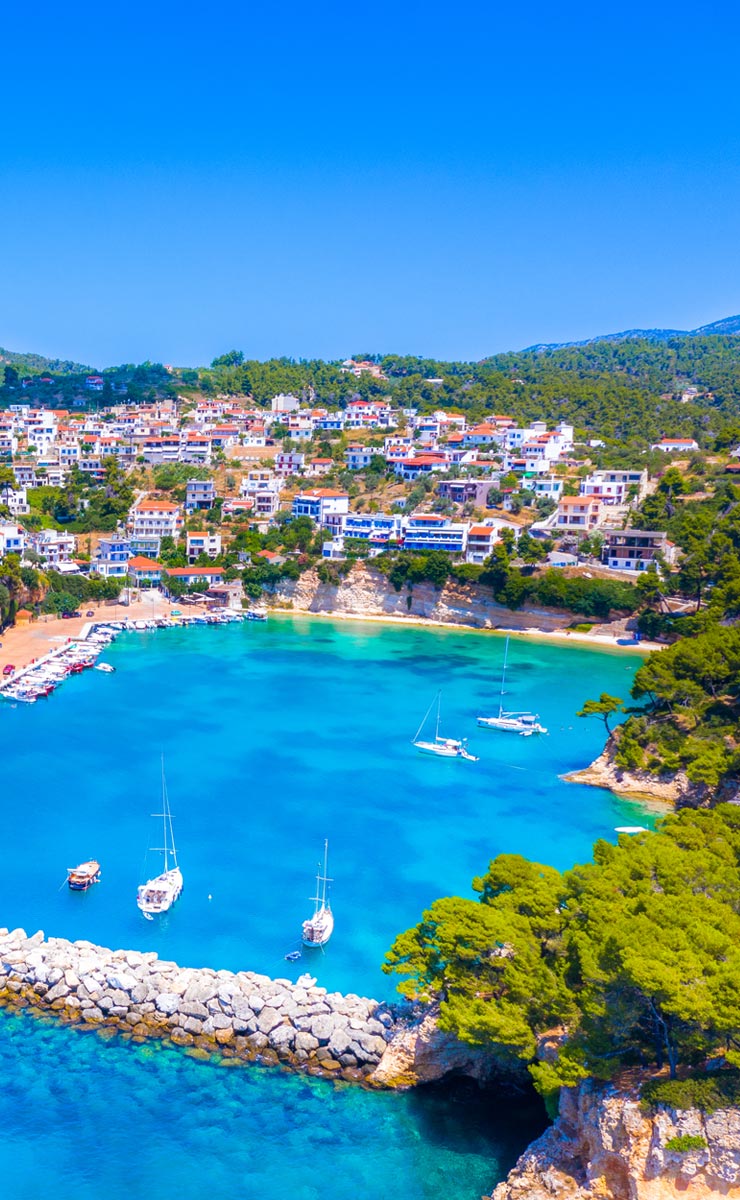Alonissos is one of the lesser visited of the Sporades. That makes this middle island of the Sporades archipelago is a little different from its fellows. It is a long, narrow, green island of just under 3,000 year-round residents, about 20 km long and 4 km wide, and is oriented northeast-southwest. Its port is Patitiri, and its capital is the inland village is of Alonissos, or Hora. Both towns are near the south end of the island.
Its character as a separate entity, that is, as a place that has not been overdeveloped and has retained its historical cohesiveness is underscored by the presence of the National Marine Park of the Northern Sporades, one of only two of its kind in Greece (the other is in Zakynthos). At over 2,000 square kilometers, it's one of the largest protected marine reserves in Europe.
The island is characterized by its green forests, its marble-like exposed rock faces, some of which have reddish striations, the relatively level ground near its coasts, and the modest mountain upland interior. Its highest points are less than 500 meters, whereas many other Greek islands have mountain peaks of 1,000 meters or higher. Its beaches tend to be pebbly rather than sandy. Alonissos has a fine network of hiking trails. It's the chief island of a small archipelago of its own- it's surrounded by several small islands: Peristera 16 sq. km, Kyra-Panagia 25 sq. km, Gioura 14 sq. km, Skantzoura 12 sq. km, Piperi 8 sq. km, Psathoura 1 sq. km, Dio Adelfi 3 sq. km, and others.
While there are plenty of accomodations to choose from, Alonnisos's development as a tourist mecca has been slow, steady, and non-disruptive to the local environment. Its heavy forests give fresh oxygen to air that is already scrubbed fresh and clean by the winds off the Mediterranean.
HISTORY
The name "Alonissos" comes from a compound of "Als," ("Salt"), and "nissos," ("island"), or "Salt Island," perhaps meaning "island out of the sea". Alonissos adopted its current name rather recently, only in 1838, after Greece had gained her independence from the Ottoman Empire in 1829. Before that it had been known as Ikos, while a nearby, smaller island, Kyra Panagia, 6 km to the northeast, was probably the original Alonissos.
Not a great deal is known of the island in pre-history, other than the high probability that it was inhabited by an offshoot of a pre-Greek Pelasgian tribe known as the Dolopes. It is believed that the Minoans from Crete planted colonies on Alonissos sometime around the 16th century, BC. A legendary Cretan hero and son of Dionysios, god of wine, known as Staphylos ("Grape") took charge of the island, introduced viticulture, and Alonissos became known for its wine production.
The Mycenaeans supplanted the Minoansaround 1,000 BC. The Dolopes, who hadn't gone anywhere, are believed to have evolved into a sort of a piratical culture which, after regaining control of Alonissos, began terrorizing ships and neighboring islands during the Geometric period (8th century, BC).
Kimon of Athens put a stop to this in the 5th century, BC, and annexed Ikos/Alonissos in 476 BC. Alonissos's claim to fame in the succeeding centuries was its fine wine. It continued to produce great wines on up to recent times, when its grape vines were wiped out by a plant disease.
Macedon's King Philip was next, in 343 BC. The claims of the Macedonians on a possession of Athens, which the Macedonians had apparently taken, prompted a speech by the great Athenian orator Demosthenes named "About Alonissos." The Macedonians, it appears, never made a proper colony of the island, perhaps because of the much wider vision for conquest of Philip's son and heir, Alexander. During the 3rd century, the entire island was a sort of vineyard for Hymnais, a wine producer from next door Skopelos (then called Perarithos), and it was given over to the production of wine, and pottery containers for the export of wine. The Romans took over the island in 190, BC, and it was turned into an exile island.
Alonissos became part of the Byzantine Empire in the early centuries of the Christian era, during which a number of buildings and fortifications were raised, many of them still standing. The Venetians captured Alonissos and the rest of Sporades in 1207, and improved on already existing fortifications. Some 200 years later, the Ottoman Turks captured the island. Nearly 400 years later, after a nearly decade-long war of revolution, Alonissos was re-united with newly independent Greece in 1830.
In 1958 the vines were destroyed by the phylloxera (dry leaf) blight, carried by tiny, sap-sucking, aphid-like insects. The island went through a major earthquake in 1965 which caused structural damage to many of its buildings. Many of the residents of the old capital of Alonissos moved to Patitiri, a couple kilometers away on the coast.












